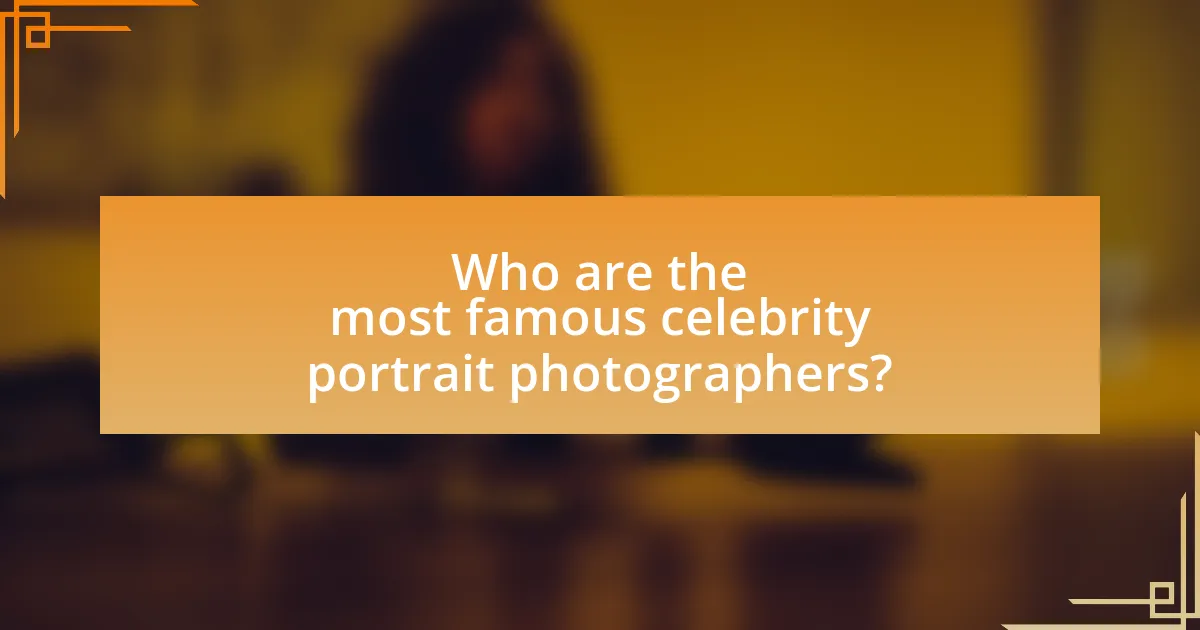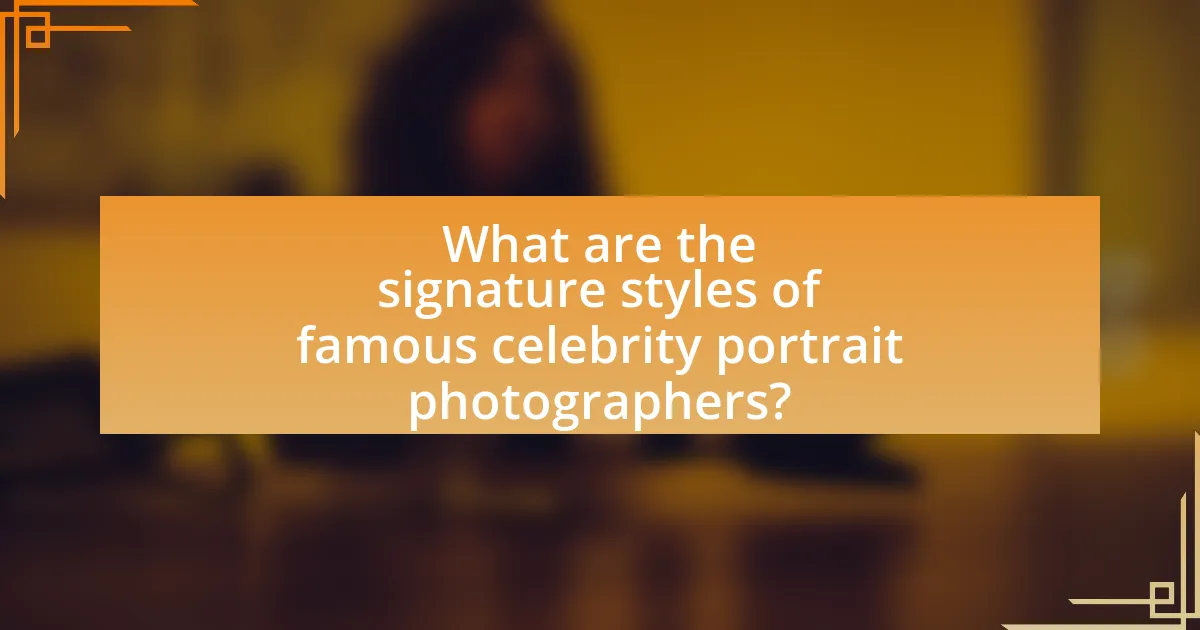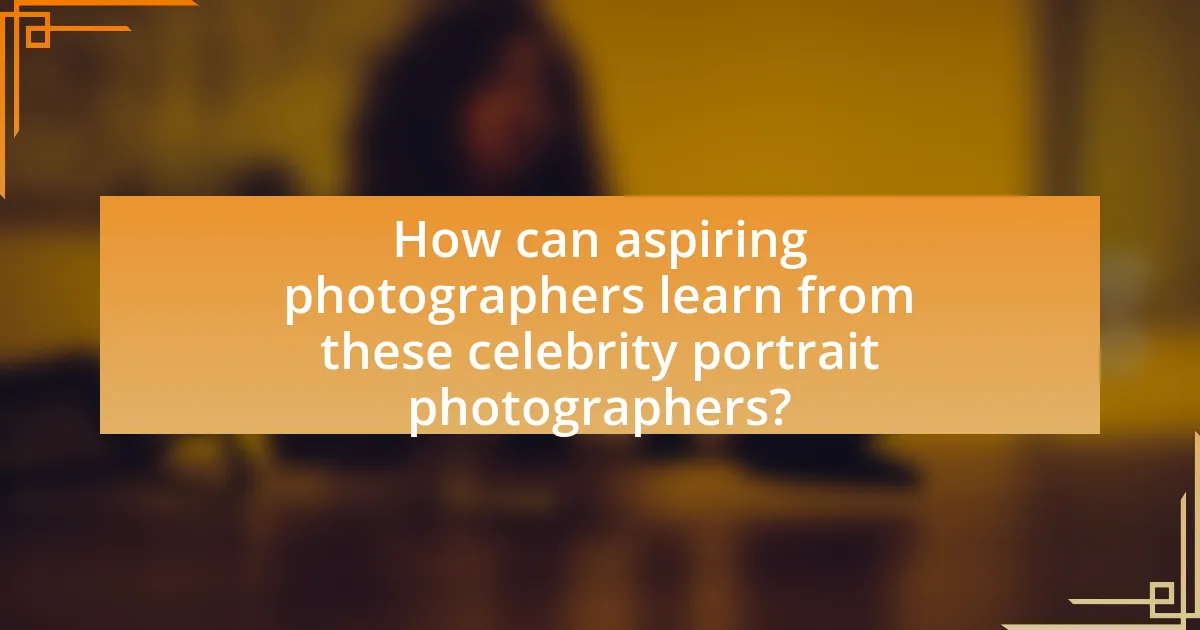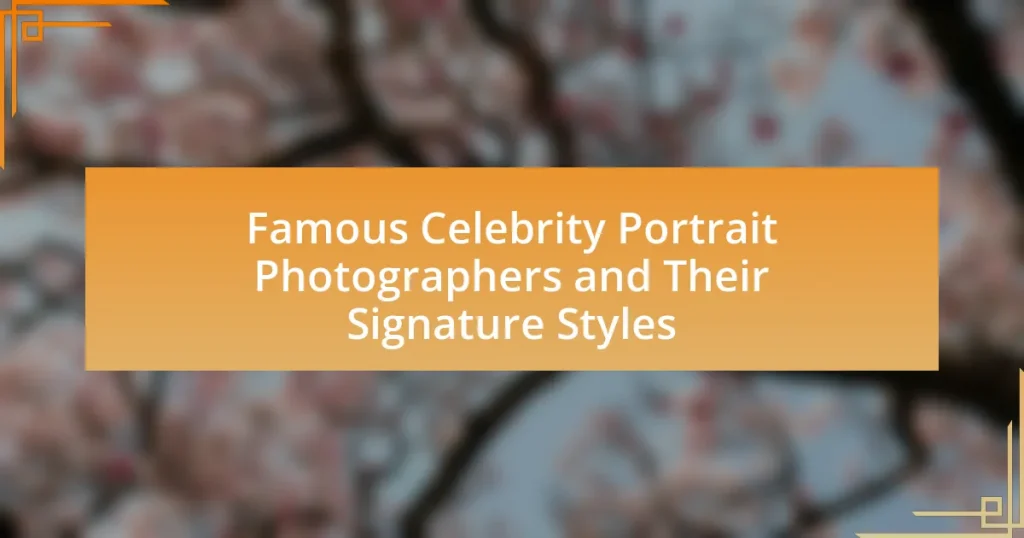The article focuses on famous celebrity portrait photographers, highlighting their distinctive styles and contributions to the field of photography. Key figures such as Annie Leibovitz, Richard Avedon, and Mario Testino are examined for their unique techniques, including lighting and composition, which enhance the emotional depth and personality of their subjects. The article also explores how their backgrounds influence their artistic approaches, the themes they address in their work, and the impact they have had on celebrity culture and visual storytelling. Additionally, practical tips for aspiring photographers are provided, emphasizing the importance of mastering lighting, composition, and post-processing to develop a unique photographic style.

Who are the most famous celebrity portrait photographers?
The most famous celebrity portrait photographers include Annie Leibovitz, Richard Avedon, and Mario Testino. Annie Leibovitz is renowned for her intimate and dramatic portraits, often capturing celebrities in unique settings, which has made her work iconic in publications like Vanity Fair. Richard Avedon is celebrated for his stark, high-contrast images that reveal the personality of his subjects, significantly influencing fashion photography. Mario Testino is known for his glamorous and vibrant portraits, particularly of models and celebrities, which have graced the covers of Vogue and other major magazines. These photographers have shaped the field of celebrity portraiture through their distinctive styles and contributions to visual culture.
What are the defining characteristics of their work?
The defining characteristics of famous celebrity portrait photographers’ work include a strong emphasis on capturing the personality and essence of their subjects, often through innovative lighting techniques and unique compositions. These photographers utilize a variety of styles, such as candid shots that reveal genuine emotions, or meticulously staged portraits that highlight the subject’s status and persona. For instance, Annie Leibovitz is known for her dramatic use of color and storytelling elements, while Richard Avedon focused on stark, high-contrast images that stripped away distractions to reveal the subject’s character. Such techniques not only enhance the visual appeal but also create a deeper connection between the viewer and the subject, making their work memorable and impactful.
How do their backgrounds influence their photography style?
The backgrounds of famous celebrity portrait photographers significantly influence their photography style by shaping their perspectives, techniques, and subject choices. For instance, a photographer with a background in fine arts may emphasize composition and lighting, resulting in more artistic and stylized portraits, while one with a journalistic background might focus on candid moments and storytelling, capturing the essence of their subjects in a more documentary style. This influence is evident in the work of photographers like Annie Leibovitz, whose early experiences in theater and art inform her dramatic and narrative-driven portraits, showcasing how personal history can directly impact artistic expression.
What techniques do they commonly use in celebrity portrait photography?
Celebrity portrait photographers commonly use techniques such as controlled lighting, composition, and posing to create striking images. Controlled lighting, often utilizing softboxes or reflectors, helps to enhance facial features and create mood. Composition techniques, including the rule of thirds and leading lines, guide the viewer’s eye and add depth to the portrait. Posing is carefully directed to convey personality and emotion, often involving the use of props or specific angles to highlight the subject’s best attributes. These methods are essential in producing high-quality portraits that resonate with audiences and capture the essence of the celebrity.
Why are these photographers considered iconic in the industry?
These photographers are considered iconic in the industry due to their unique ability to capture the essence of their subjects, often leading to groundbreaking visual storytelling. Their work has not only defined celebrity portraiture but has also influenced broader trends in photography. For instance, Annie Leibovitz is renowned for her dramatic and intimate portraits, which have graced the covers of major publications like Vanity Fair and Rolling Stone, showcasing her distinctive use of lighting and composition. Similarly, Richard Avedon revolutionized fashion photography with his stark, minimalist style and ability to convey emotion, as seen in his famous series “In the American West.” These contributions have established them as pivotal figures in the evolution of photographic art, solidifying their iconic status.
What awards or recognitions have they received?
The famous celebrity portrait photographers have received numerous awards and recognitions, including prestigious honors such as the International Photography Awards, the Lucie Awards, and the National Portrait Gallery’s Taylor Wessing Photographic Portrait Prize. For instance, photographers like Annie Leibovitz have been recognized with multiple awards, including the American Society of Magazine Editors’ Magazine Cover of the Year. These accolades highlight their significant contributions to the field of portrait photography and their impact on visual culture.
How have they shaped the perception of celebrity culture through their work?
Famous celebrity portrait photographers have shaped the perception of celebrity culture by capturing intimate and often idealized representations of their subjects, influencing public perception and media narratives. For instance, photographers like Annie Leibovitz have created iconic images that blend artistry with celebrity, showcasing not just the fame but also the personal stories behind the personas, as seen in her famous portrait of John Lennon and Yoko Ono. This approach has contributed to a more nuanced understanding of celebrities, transforming them from mere public figures into relatable individuals with complex lives. Additionally, the work of photographers such as Richard Avedon, known for his stark and revealing portraits, has challenged traditional notions of beauty and glamour, prompting audiences to reconsider their perceptions of celebrity authenticity and vulnerability.

What are the signature styles of famous celebrity portrait photographers?
Famous celebrity portrait photographers exhibit distinct signature styles that define their work. Annie Leibovitz is known for her dramatic lighting and storytelling approach, often capturing subjects in elaborate settings that reflect their personalities. Richard Avedon’s style is characterized by stark, high-contrast black-and-white images that emphasize the subject’s emotions and expressions, creating a sense of intimacy. Mario Testino employs vibrant colors and glamorous aesthetics, often showcasing celebrities in luxurious environments, which enhances their allure. Helmut Newton is recognized for his provocative and edgy compositions, blending fashion with fine art to create striking visual narratives. Each photographer’s unique style not only highlights their artistic vision but also influences the broader landscape of celebrity portraiture.
How do lighting and composition play a role in their signature styles?
Lighting and composition are crucial elements that define the signature styles of famous celebrity portrait photographers. Effective lighting enhances the subject’s features, creates mood, and establishes depth, while composition dictates the arrangement of elements within the frame, guiding the viewer’s eye and conveying the intended message. For instance, photographers like Annie Leibovitz utilize dramatic lighting to evoke emotion and highlight the personality of their subjects, often employing soft, diffused light to create a flattering effect. Similarly, Richard Avedon’s use of stark, high-contrast lighting emphasizes the details of his subjects, contributing to the iconic, clean aesthetic of his portraits. The interplay of these elements not only showcases the subjects effectively but also reflects the unique artistic vision of each photographer, making lighting and composition integral to their signature styles.
What specific lighting techniques are favored by these photographers?
Famous celebrity portrait photographers often favor techniques such as Rembrandt lighting, butterfly lighting, and natural light. Rembrandt lighting, characterized by a triangle of light on the subject’s cheek opposite the light source, creates depth and dimension, enhancing facial features. Butterfly lighting, which produces a soft shadow under the nose, is popular for its flattering effect on the face, particularly in beauty photography. Natural light is frequently utilized for its ability to create a soft, organic look, often employed in outdoor settings or near windows to achieve a candid feel. These techniques are widely recognized in the photography community for their effectiveness in highlighting the subject’s features and creating mood.
How does composition vary among different photographers?
Composition varies among different photographers based on their unique artistic vision, techniques, and the emotional impact they aim to convey. For instance, Annie Leibovitz often employs dramatic lighting and poses to create a narrative, while Richard Avedon focuses on stark backgrounds and direct eye contact to emphasize the subject’s personality. These compositional choices reflect their individual styles and influence how viewers perceive the subjects. Studies in photography highlight that such variations in composition can significantly affect the viewer’s emotional response and interpretation of the image.
What themes or concepts are commonly explored in their portraits?
Common themes explored in portraits by famous celebrity photographers include identity, emotion, and cultural commentary. These photographers often capture the essence of their subjects, revealing personal narratives and societal reflections. For instance, Annie Leibovitz frequently emphasizes the interplay between celebrity and vulnerability, showcasing her subjects in intimate settings that highlight their humanity. Similarly, Richard Avedon focused on the stark contrasts of personality and persona, often using minimalist backgrounds to draw attention to the subject’s expression and character. These thematic explorations not only enhance the visual impact of the portraits but also invite viewers to engage with deeper societal issues and personal stories.
How do they convey emotion and personality through their work?
Famous celebrity portrait photographers convey emotion and personality through their work by utilizing techniques such as lighting, composition, and candid moments. For instance, Annie Leibovitz often captures her subjects in intimate settings, using natural light to evoke a sense of authenticity and vulnerability. This approach allows viewers to connect emotionally with the subjects, as seen in her iconic portrait of John Lennon and Yoko Ono, which conveys deep intimacy and love. Additionally, photographers like Mario Testino employ vibrant colors and dynamic poses to reflect the personality and energy of their subjects, as demonstrated in his work with celebrities like Kate Moss, where the playful yet sophisticated style highlights her character. These methods not only enhance the visual appeal but also create a narrative that resonates with the audience, effectively conveying the essence of the individuals portrayed.
What cultural or social issues do they address in their photography?
Famous celebrity portrait photographers address various cultural and social issues, including identity, representation, and social justice. For instance, photographers like Annie Leibovitz often explore themes of gender and sexuality through their subjects, capturing the complexities of personal identity in a public sphere. Additionally, photographers such as Martin Schoeller highlight issues of diversity and inclusion by portraying individuals from different backgrounds, emphasizing the importance of representation in media. These approaches not only reflect societal norms but also challenge them, prompting discussions around race, gender, and the human experience.

How can aspiring photographers learn from these celebrity portrait photographers?
Aspiring photographers can learn from celebrity portrait photographers by studying their techniques, understanding their creative processes, and analyzing their use of lighting and composition. For instance, photographers like Annie Leibovitz and Richard Avedon are known for their distinctive styles that often involve dramatic lighting and unique poses, which aspiring photographers can replicate in their own work. Additionally, many of these photographers share insights through interviews, workshops, and online tutorials, providing practical advice on capturing emotion and personality in portraits. By emulating their methods and incorporating feedback from their work, aspiring photographers can enhance their skills and develop their own signature styles.
What techniques can be adopted to develop a unique style?
To develop a unique style in photography, one can adopt techniques such as experimenting with lighting, composition, and post-processing. For instance, utilizing natural light versus artificial light can create distinct moods and highlights in portraits. Additionally, varying angles and framing can lead to innovative compositions that stand out. Post-processing techniques, like color grading or specific editing styles, can further enhance individuality. Notably, photographers like Annie Leibovitz are recognized for their signature use of dramatic lighting and storytelling elements, which contribute to their unique styles. This approach demonstrates that a combination of technical skills and personal expression is essential in cultivating a distinctive photographic identity.
How can one experiment with lighting and composition effectively?
To experiment with lighting and composition effectively, one should utilize various light sources and angles while adjusting the framing of the subject. For instance, using natural light at different times of the day can create diverse moods, while artificial lights can be manipulated to highlight specific features or create shadows. Additionally, altering the composition by changing the perspective, such as shooting from above or below, can significantly impact the visual narrative. Studies in photography emphasize that varying these elements leads to a deeper understanding of how light and composition interact, enhancing the overall quality of the portrait.
What resources are available for studying their work?
Resources available for studying the work of famous celebrity portrait photographers include books, online courses, and photography exhibitions. Notable books such as “Annie Leibovitz: Portraits 2005-2016” provide insights into the techniques and styles of prominent photographers. Online platforms like MasterClass offer courses taught by renowned photographers, allowing for direct learning from their experiences. Additionally, exhibitions at galleries and museums often showcase the works of these photographers, providing a visual context and deeper understanding of their artistic approaches.
What practical tips can help improve portrait photography skills?
To improve portrait photography skills, focus on mastering lighting techniques, as they significantly influence the mood and clarity of the image. Utilizing natural light during golden hour enhances skin tones and creates a soft, flattering effect. Additionally, experimenting with different angles and perspectives can reveal unique features and expressions, making the portrait more engaging. Understanding composition rules, such as the rule of thirds, helps in framing the subject effectively, drawing attention to their face. Lastly, practicing with various lenses allows for creative depth of field effects, isolating the subject from the background. These techniques are supported by the fact that professional photographers often emphasize the importance of light and composition in their work, as seen in the styles of renowned portrait photographers like Annie Leibovitz and Richard Avedon.
How important is post-processing in achieving a signature style?
Post-processing is crucial in achieving a signature style, as it allows photographers to refine their images and express their unique artistic vision. This stage enables the adjustment of colors, contrast, and textures, which can significantly alter the mood and aesthetic of a photograph. For instance, renowned photographers like Annie Leibovitz and Peter Lindbergh utilize post-processing techniques to enhance their distinctive styles, making their work instantly recognizable. The ability to manipulate images in post-processing has been shown to contribute to a photographer’s brand identity, as consistent editing styles can create a cohesive body of work that resonates with audiences.
What common mistakes should photographers avoid when capturing portraits?
Photographers should avoid poor lighting, which can lead to unflattering shadows and highlights in portraits. Proper lighting is crucial for capturing the subject’s features accurately and creating a mood. Additionally, photographers often make the mistake of neglecting the background, which can distract from the subject; a cluttered or inappropriate background can detract from the overall composition. Another common error is failing to communicate with the subject, resulting in stiff or unnatural poses; effective direction can help elicit genuine expressions. Lastly, photographers should avoid using inappropriate focal lengths, as this can distort facial features; using a lens with a focal length between 85mm and 135mm is generally recommended for flattering portraits.



